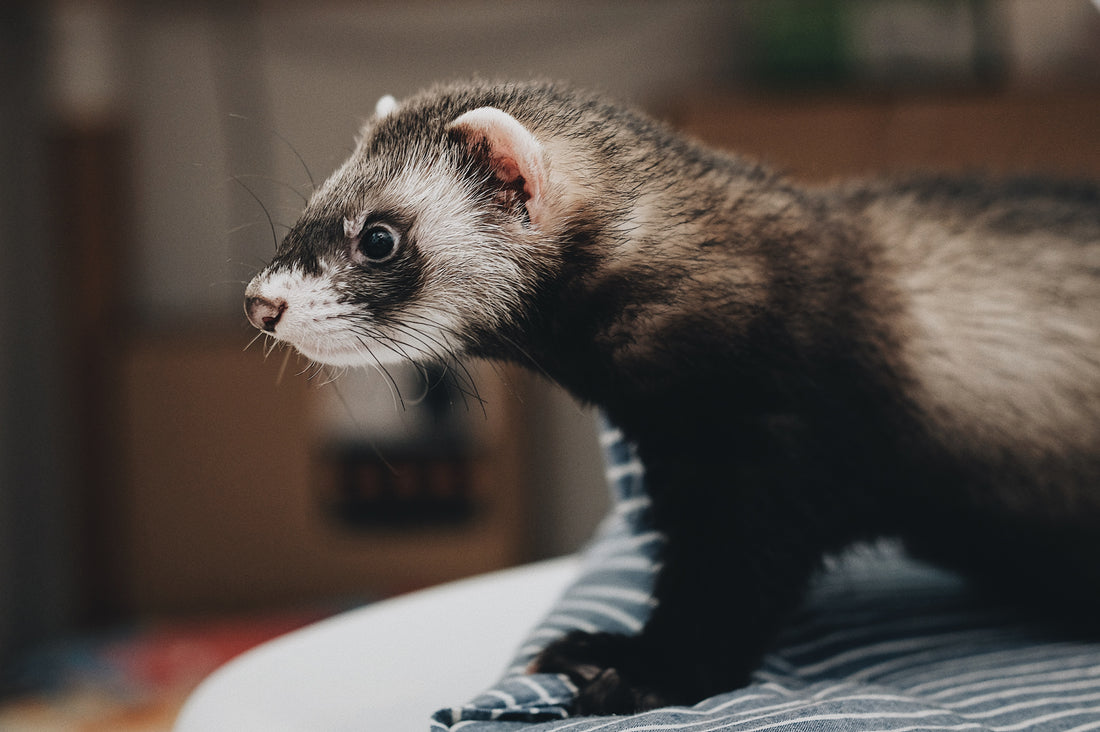Basic Information
-
Species: Ferret (Mustela putorius furo)
-
Lifespan: 5 - 10 years on average
-
Adult Size: 13 - 15 inches in length and 1.5 - 4 pounds
- Native Habitat: The domesticated ferrets we know today do not exist in the wild.
Habitat
There are a few different cage options that will meet the overall requirements for your ferret. The main factors in deciding on the cage will to ensure they have adequate floor space but also vertical space to add hammocks and tunnels. We generally recommend the cage to meet the following requirements:
- Multiple Levels
- Flat bottom (Wire bottoms can be damaging to feet)
- Wire sided to allow for plenty of ventilation
- Adequate space for dishes, hammocks, tunnels, beds, etc...
Many may also choose to allow their ferret to free roam the majority of their time, choosing only to cage when absolutely necessary. If that's the case you can use something smaller, around 3' x 2' x 2. However, our two favorites are:
Both of these cages are multi-level, measuring roughly 36" Long x 25" Wide x 62.5" Tall. This is also large enough to accommodate two ferrets comfortably with plenty of space for both.
We still recommend you provide a few hours of free roam time per day, but they will spend the vast majority of their time sleeping. The Midwest is our number one choice, but Prevue is the cheaper alternative.
Diet & Nutrition
Ferrets are strict carnivores, meaning they both love and need to eat meat. In the wild their diet will consist of raw meat, bones, and other animal tissue. Although they may enjoy eating sweets, dairy, and vegetables, these foods should be avoided.
But what should you actually feed them? The best choice would be a balanced raw meat diet of meat, bones, and organs. The general rule of thumb is 80/10/10, or 80% meat, 10% bone, and 10% organs.
As babies, up until they're about 1 year of age, they'll eat roughly 10% of their body weight per day. After reaching adulthood, this will be cut back quite a bit, eating roughly 3% of their body weight per day.
If you instead choose to go with a kibble diet, there are a few good alternatives. We'll just want
Grooming
Despite their musky odor, ferrets are naturally clean animals. No matter how often you bathe them, that odor will never completely disappear so avoid bathing them too frequently.
You'll actually want to keep baths as minimal as possible, at most once or twice per month. Surprisingly, overbathing can actually force their body to generate more natural oils to compensate making the odor even stronger.
Required Supplies
You have a lot of different options and setups that work great, but there are a few basic things you'll need regardless. That includes:
- Enclosure: You have several choices for caging, especially if you plan on a great deal of free roam time. Our two favorites include the Midwest Ferret Nation and Prevue Feisty Ferret Cage. Just make sure they meet these basic requirements:
- 3' x 2' x 2' (Ideally 36" Long x 25" Wide x 62.5" Tall)
- No wire bottom (hurts feet)
- Small spacing between bars if using wire sided cage
- Hides: We like to provide a couple of cloth hideaways for them to snuggle up in if they decide to.
- Climbing Obstacles: This will include hammocks, tunnels, fleece cut outs, etc..
- Water Bowl: Can use either water bowl, or bottle, we prefer to provide both. They do wash their face at times much like a cat so a bowl is nice to include.
- Food Bowl: You will likely need two food dishes. One for the kibble and one for raw meet if you plan to provide a mix of both.
- Food: Refer to the diet and nutrition section, but you'll want to provide a staple diet of a high quality protein rich kibble or a raw meat diet. That could include:
- Wysong Ferret Epigen 90
- ZuPreem Grain Free Ferret Food
- Marshall Premium Ferret Diet
- Raw meat, bones, and organs
- Bedding: Many options will work fine including fleece liners, paper bedding, or eco bedding.. Just avoid cedar shaving as it is toxic.
Our Available Ferrets
If you've done your research and decided to add a Ferret to your family, you can view all our available ferrets here.

